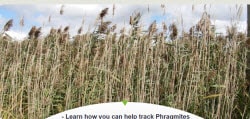Concern it could becomes an upland weed
By Laurissa Christie, University of Guelph Agricultural Communications Student, for Farms.com
One of Ontario’s most disastrous invasive species is having catastrophic effects on wetlands, water quality and drainage, and may ultimately impact the future of farms in Ontario.
Phragmites, also known as the common reed, is invading wetlands, ditches and shorelines. In 2005, Agriculture and Agri-Food Canada referred to it as Canada’s worst invasive species. This pest can grow six metres high and quickly destroy water drainage and biodiversity. David Armitage, director of regulatory modernization at the Ontario Federation of Agriculture (OFA), says the pest is now found mostly in lowland areas, but the agricultural community fears it might become an upland weed or field weed if left unchecked. He urges farmers to keep an eye out for phragmites on their property to protect the environment.
“The awareness level up to now has been slow, but is increasing with time," he says. "My hope is that in 10 years we will have it under control.”
Eradicating phragmites is challenging. One problem is that it grows close to water. This means herbicide registration agencies are reluctant to approve treatment options, for fear of chemical contaminants in the water. But Armitage says the Pest Control Regulatory Agency needs to recognize the problem, and ensure that there are safe control products registered and available for use.
Currently, the only control method is to mechanically remove the species. But, there are concerns about phragmites re-establishing due to equipment contamination and disposal.
Some parallels between the purple loosestrife invasion in the 1990s and the current phragmites invasion are evident. In the 1990s, a biological beetle was used to eradicate the purple loosestrife species. As far as Armitage is aware, there are no biological controls being studied for phragmites. He urges caution if biological controls are used to ensure that another invasive species problem is not introduced.
But, Armitage says something must be done for control. The problem was introduced to the OFA in the spring in a presentation by a wetlands biologist. The presentation was not agriculturally focused, however, OFA soon realized that phragmites could be a problem for agriculture if it clogs drainage ditches. “We have the tools in place through the Drainage Act to ensure that drains are maintained through the removal of phragmites, but removal will add cost. The major concern is if it becomes an upland weed,” Armitage says.
The province also has native phragmites, which play an important ecosystem role, so caution needs to be used to maintain the native variety and eradicate invasive phragmites. Invasive phragmites can be identified by their dense population and blue–green leaves. Native phragmites have green–yellow leaves and do not grow as close together.
Earlier last month, the province re-introduced a proposed Invasive Species Act with stricter regulations and inspections as one step to try to help resolve the problem. This Act is designed to ensure that invasive species do not become dominant and will assign removal cost responsibility to the government. There has also been a working group developed to tackle the issue and promote species education.
 Editors Note: OMAFRA has a website and tool kit available to help farmers learn more about phragmites.
Editors Note: OMAFRA has a website and tool kit available to help farmers learn more about phragmites.
Laurissa Christie is a 3rd year Environmental Sciences student at the University of Guelph. Laurissa grew up on a broiler chicken and red deer farm near Tara, Ontario. She is actively involved in her school community through the Student Federation of Ontario Agricultural College, Environmental Sciences Student Executive, College Royal and Student Senate. At home, Laurissa is a skating coach and past Bruce County Queen of the Furrow. Laurissa’s interests include: climate change, travelling, the Arctic, Antarctic, glaciology and sustainable agriculture. Last summer, Laurissa cross country skied across glaciers in Alaska conducting research with the Juneau Icefield Research Program. Laurissa has done presentations on environmental issues to thousands of people to inspire them to make changes to their life. This article is part of Laurissa Christie’s course work for the University of Guelph agricultural communications course, instructed by Prof. Owen Roberts.